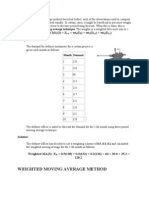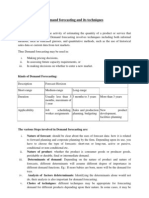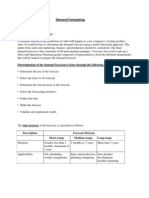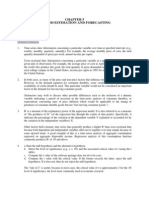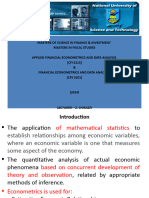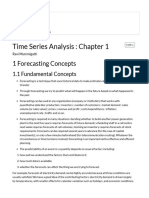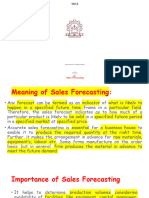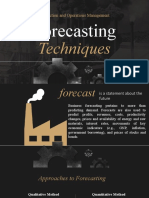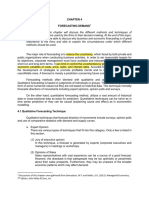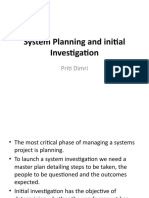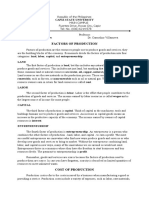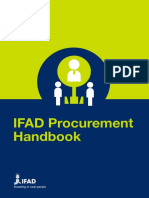0 ratings0% found this document useful (0 votes)
39 viewsDemand Forecasting: Prof. A.N. Sah
Demand Forecasting: Prof. A.N. Sah
Uploaded by
hadspotThis document discusses demand forecasting methods. It begins by defining demand and explaining the significance of forecasting for businesses. It then describes both qualitative and quantitative forecasting methods. Qualitative methods include judgemental forecasting using experienced individuals. Quantitative methods rely on numerical data and include techniques like naive models, moving averages, exponential smoothing, linear regression, trend models, and using dummy variables to account for seasonality. The document provides examples and explanations of how to apply these various demand forecasting techniques.
Copyright:
Attribution Non-Commercial (BY-NC)
Available Formats
Download as PPTX, PDF, TXT or read online from Scribd
Demand Forecasting: Prof. A.N. Sah
Demand Forecasting: Prof. A.N. Sah
Uploaded by
hadspot0 ratings0% found this document useful (0 votes)
39 views24 pagesThis document discusses demand forecasting methods. It begins by defining demand and explaining the significance of forecasting for businesses. It then describes both qualitative and quantitative forecasting methods. Qualitative methods include judgemental forecasting using experienced individuals. Quantitative methods rely on numerical data and include techniques like naive models, moving averages, exponential smoothing, linear regression, trend models, and using dummy variables to account for seasonality. The document provides examples and explanations of how to apply these various demand forecasting techniques.
Original Title
Demand Forecasting
Copyright
© Attribution Non-Commercial (BY-NC)
Available Formats
PPTX, PDF, TXT or read online from Scribd
Share this document
Did you find this document useful?
Is this content inappropriate?
This document discusses demand forecasting methods. It begins by defining demand and explaining the significance of forecasting for businesses. It then describes both qualitative and quantitative forecasting methods. Qualitative methods include judgemental forecasting using experienced individuals. Quantitative methods rely on numerical data and include techniques like naive models, moving averages, exponential smoothing, linear regression, trend models, and using dummy variables to account for seasonality. The document provides examples and explanations of how to apply these various demand forecasting techniques.
Copyright:
Attribution Non-Commercial (BY-NC)
Available Formats
Download as PPTX, PDF, TXT or read online from Scribd
Download as pptx, pdf, or txt
0 ratings0% found this document useful (0 votes)
39 views24 pagesDemand Forecasting: Prof. A.N. Sah
Demand Forecasting: Prof. A.N. Sah
Uploaded by
hadspotThis document discusses demand forecasting methods. It begins by defining demand and explaining the significance of forecasting for businesses. It then describes both qualitative and quantitative forecasting methods. Qualitative methods include judgemental forecasting using experienced individuals. Quantitative methods rely on numerical data and include techniques like naive models, moving averages, exponential smoothing, linear regression, trend models, and using dummy variables to account for seasonality. The document provides examples and explanations of how to apply these various demand forecasting techniques.
Copyright:
Attribution Non-Commercial (BY-NC)
Available Formats
Download as PPTX, PDF, TXT or read online from Scribd
Download as pptx, pdf, or txt
You are on page 1of 24
Demand Forecasting
Prof. A.N. Sah
What is demand
Demand: In economics, demand refers to the amount
of quantity demanded for a product at a particular price
during a given period of time.
Market Demand: Sum of individual demands. It
refers to total volume that would be bought by a
defined customer group in a defined geographical area
during a given time period.
Market Potential: Market potential refers to the
upper limit of market demand.
What is forecasting?
Forecasting is defined as “Estimating in unknown
situations. In the context of a company, it refers to the
estimates of future sales of the company’s products.
“A successful business manager is a forecaster first;
purchasing, producing, marketing, pricing, and
organizing all will follow it.”
Significance of Forecasting for Business
The area of business forecasting revolves around
demand forecasting, for marketing and production for
shorter horizons.
Marketing department forecasts sales for new product
lines to give strategic information about their sales later
at maturity.
It also forecasts sales for existing product lines to give
feedback on whether the current sales techniques are
working well or not.
Such forecasts are called short range strategic forecasts
which are done usually for 1 to 2 years.
Cont..
Besides this, there is tactical and requirements
forecasting that is done for a very short to short
horizons of 1 week to 12 months with a typical
horizons of 6 to 12 weeks.
Actually, for producing short strategic and tactical
forecasts, we make use of objective forecasting
methods such as smoothing techniques, causal
methods etc.
Cont..
Finally, long range strategic forecasting, usually for a
period comprising from 2 to 10 years is done. Some of
the techniques used under this are surveys, panel of
experts and the Delphi method. It is this strategic
forecasting which tends to make or break companies.
Cont…
In the forecasting process, the identification of the
problem is the most difficult part. It involves
identifying the exact variable of interest, that is, to be
forecasted which requires a deep understanding of the
system. It raises some critical questions such as:
how the forecasts will be used in the organization,
who requires the forecasts
and for what purpose, and how the whole forecasting
exercise fits within the organization.
Demand Forecasting Methods
There is a wide variety of forecasting techniques availabe.
They range from relatively informal qualitative methods
to highly advanced quantitative methods of forecasting. It
is important to note that advanced and sophisticated does
not necessarily mean more accurate forecasts.
Sometimes guess estimate by experienced people in the
industry has a very high accuracy. However, forecasters
use wide range of techniques, recognizing that some
techniques might perform better than others depending
upon nature of data.
Qualitative Methods
Qualitative forecasting technique is based on
judgements about future. These are often called
judgemental or nonextrapolative techniques.
In this type of forecasting, dependence on numbers are
not only small but they also lack rigourous
specification of the underlying assumption.
Judgemental forecasting is one of the important
techniques of forecasting. In this method, an individual
or small group of people prepare forecasts regarding
likely future conditions.
Cont…
When used by experienced persons keeping in mind
historical trends, current economic situations and other
relevant factors, this method can produce good estimates.
This method, however, tend to work best when
environment changes very rapidly. When economic and
political conditions are very stable, quantitative methods
may yield very good estimates.
However, when economic and political environment are
in flux, quantitative methods may not capture important
clues which have the ability to change the historical
patterns in a country.
Quantitative Methods
Quantitative methods of forecasting rely on numerical data.
Data is the bread and butter of quantitative methods. There are
two general types of quantitative methods.
First, the time series methods that consists of numerous
techniques that use past trends to predict future conditions.
Second, causal models that use the variables assumed to
influence another variable. In general, quantitative methods
perform better job than qualitative methods in predicting future.
Finally, time series methods outperform causal models at least
in near term. Time series methods of forecasting are discussed
below:
1. Naïve Model
A naive model simply assumes the value in previous
period as the forecasted value in the current period. In
other words, the value of a variable at time t is the
same as the value at time t-1. This model is also called
random walk model which is specified as follows:
Y(t) =Y(t-1)
Cont..
where Yt is the forecasted value at time t, and Yt-1 is
the actual value at time t-1.
A variant of naive model involves taking average of
two prior values to generate forecast.
Another variation of naive modelling involves
incorporating trend that may be present in data.
Data 1.xlsx
2.Moving Average
Moving average is a very common time series
technique of forecasting. It is very frequently used by
technical analyst in predicting stock prices, interest
rates, foreign exchange rates etc.
In moving average old data points are excluded as new
ones are added. As a consequence, the most recent
information is utilized in obtaining each new moving
average.
Cont…
The optimal time period to include in the computation of
moving average depends on the degree of variation in
the data.
If there is high degree of random component present in
the data then a longer period is used.
Similarly, the presence of cyclicality and seasonality in
the data also requires a longer period to smooth the data.
In practice, trial and error method is used to arrive at the
best fitting model that minimizes forecast error.
Data2.xlsx
3. Exponential Smoothing
Another popular time series forecasting technique is
exponential smoothing.
While moving average technique gives equal weight to
each data points, exponential smoothing assigns
exponentially declining weights as the observation get
older.
In other words, exponential smoothing technique gives
relatively more weight to recent observations and less
weight to older observation. Symbolically, exponential
smoothing is expressed as follows:
Ft+1=α.Xt+ (1-α) Ft
Cont…
where
Ft+1= the forecast for the next time period (t+1)
Ft= the forecast for the present time period (t)
Xt = the actual value for the present time period
α = a value between 0 and 1 referred to as the
exponential smoothing constant.
Cont…
The value of α is determined by the forecaster. If α is
chosen to be less than 0.5, less weight is placed on the
actual value than on the forecast of that value. If α is
chosen to be more than 0.5, more weight is placed on
the actual value than on the forecast of that value
A high smoothing coefficient could be more
appropriate for new products or items for which the
underlying demand is shifting (dynamic or unstable)
Cont…
An α of .7, .8 or .9 might be best for these conditions.
If demand is very stable and believed to be representative
of the future, the forecaster wants to select a low value of
α to smooth out any sudden noise that might have
occurred.
Under these stable conditions, an appropriate smoothing
coefficient might ne .1, .2 or 0.3.
When demand is slightly unstable, smoothing
coefficients of 0.4, 0.5 or 0.6 might provide the most
accurate forecast.
Data3.xlsx
Linear Regression
Regression analysis is a statistical tool for analyzing the nature of
relationship between two variables. It is an important tool
frequently used by economists to understand the relationship
among two or more variables. When our interest lies in
explaining one variable in terms of another variable i.e. y in terms
of x, we use regression.
Regression model studies the relationship between two variables
when one is the dependent variable and the other is an
independent variable. For example, an agriculture economist
might be interested in explaining crop yield (y) with the help of
amount of fertilizers (x) used; change in inflation (y) in terms of
change in money supply (x).
Data4.xlsx
Linear Trend Model
Trend refers to the general tendency of an economic
variable over a long time.
According to Simpson & Kafka, “ Trend also called
secular or long term trend is the basic tendency of
production, sales, income, employment, or the like to
grow or decline over a period of time.
The concept of trend does not include short –range
oscillations but, rather, steady movements over a long
time.” data5.xlsx
Seasonality: Dummy Variable
Seasonal variations in production and sales is a well
known fact in business.
Seasonality refers to regular and repetitive fluctuation
in a time series which occurs periodically over a span
of less than a year.
The main cause of seasonal variations in time series
data is the change in climate. For example, sales of
wollen clothes generally increase in winter season.
Besides this, customs and tradition also affect
economic variables for instance sales of gold increase
during marriage seasons.
Cont…
A variable which takes only two values such as 0 and 1
are called dummy variables. They are also called
categorical, indicator or binary variables in literature.
While 1 indicates the presence of an attribute, o
indicates the absence of an attribute.
data6.xlsx
Thank You
You might also like
- AFAR - PreWeek - May 2022Document31 pagesAFAR - PreWeek - May 2022Miguel ManagoNo ratings yet
- Macro & Micro Factors of "Swiggy"Document12 pagesMacro & Micro Factors of "Swiggy"Shikha goswamiNo ratings yet
- Weighted Moving AveragesDocument10 pagesWeighted Moving AveragesElle May NanezNo ratings yet
- Assessing Industry Attractiveness of Tea Industry Applying Michael Porter's Five Forces ModelDocument10 pagesAssessing Industry Attractiveness of Tea Industry Applying Michael Porter's Five Forces ModelAlphabetical LyricsNo ratings yet
- Far110 Lesson Plan For Student Semester Oct2020 - Feb2021 PDFDocument8 pagesFar110 Lesson Plan For Student Semester Oct2020 - Feb2021 PDFPredelly Maxx100% (1)
- Kayne Marquez - BME 1 - Activity 3.1Document5 pagesKayne Marquez - BME 1 - Activity 3.1Colline MarquezNo ratings yet
- Demand Forecast Process and Inventory ManagementDocument17 pagesDemand Forecast Process and Inventory ManagementAbhishek KumarNo ratings yet
- Demand Forecasting and Its TechniquesDocument5 pagesDemand Forecasting and Its TechniquesKumar RahulNo ratings yet
- Chapter 03 (Info Sheet #3)Document6 pagesChapter 03 (Info Sheet #3)Ian Alfornon100% (1)
- Chapter 3Document59 pagesChapter 3romel100% (1)
- Demand Forecasting: Determination of The Demand Forecasts Is Done Through The Following StepsDocument5 pagesDemand Forecasting: Determination of The Demand Forecasts Is Done Through The Following StepsUtkarsh KichluNo ratings yet
- The Hindu 2 MarchDocument8 pagesThe Hindu 2 Marchkushwahaking2223No ratings yet
- What Is A Demand ForecastDocument4 pagesWhat Is A Demand ForecastRajuBhuiyanNo ratings yet
- Module 6: Introduction To Time Series Forecasting: Titus Awokuse and Tom IlventoDocument26 pagesModule 6: Introduction To Time Series Forecasting: Titus Awokuse and Tom IlventoAshutoshSrivastavaNo ratings yet
- Economic Forecasting Techniques: 1. Anticipatory Surveys: Under This Prominent People inDocument3 pagesEconomic Forecasting Techniques: 1. Anticipatory Surveys: Under This Prominent People insnehachandan91No ratings yet
- PPC Unit 2 CompleteDocument55 pagesPPC Unit 2 Completer.mandy4601No ratings yet
- Demand ForecastingDocument28 pagesDemand ForecastingRamteja SpuranNo ratings yet
- CH 3Document58 pagesCH 3dip_g_007No ratings yet
- 02 OM Chapter 1 ForecastingDocument15 pages02 OM Chapter 1 ForecastingLee K.No ratings yet
- MPD412 - Ind Org - Lecture-02-Forecasting - Part ADocument26 pagesMPD412 - Ind Org - Lecture-02-Forecasting - Part AMohamed OmarNo ratings yet
- Demand Estimation and For CastingDocument4 pagesDemand Estimation and For Castinggadhiya_daxesh47No ratings yet
- Forecasting: Submitted By: Bindu Thushara. N Igtc Date: October 02, 2013Document28 pagesForecasting: Submitted By: Bindu Thushara. N Igtc Date: October 02, 2013NB Thushara Harithas100% (1)
- Forecasting TechniquesDocument26 pagesForecasting TechniquesColeen OrbegosoNo ratings yet
- Time Series ForecastingDocument11 pagesTime Series ForecastingFueNo ratings yet
- Chapter 9 - Forecasting TechniquesDocument50 pagesChapter 9 - Forecasting TechniquesPankaj MaryeNo ratings yet
- Unit 3 NotesDocument20 pagesUnit 3 Noteszaaya3103No ratings yet
- Module 2 ForecastingDocument7 pagesModule 2 ForecastingNicolas Jamon Magbanua INo ratings yet
- DLH Unit 3Document97 pagesDLH Unit 3rajs27No ratings yet
- Solutions To Chapter 5 - CompressDocument11 pagesSolutions To Chapter 5 - CompressSadia ChowdhuryNo ratings yet
- Module 4 (Forecasting)Document42 pagesModule 4 (Forecasting)HERNANDO REYESNo ratings yet
- Module 4 (Forecasting)Document42 pagesModule 4 (Forecasting)HERNANDO REYESNo ratings yet
- Demand Forecasting: 1. Survey Methods 2. Statistical Methods 3. Expert Opinion MethodsDocument3 pagesDemand Forecasting: 1. Survey Methods 2. Statistical Methods 3. Expert Opinion MethodsKuthubudeen T MNo ratings yet
- Operation Management ModuleDocument5 pagesOperation Management ModuleSteve MesaNo ratings yet
- Chapter 1 - Nature of Applied Econometrics and Economic DataDocument38 pagesChapter 1 - Nature of Applied Econometrics and Economic DataSolomonSakalaNo ratings yet
- Unit Two ForecastingDocument86 pagesUnit Two ForecastingEbisa HailuNo ratings yet
- Forecasting NotesDocument7 pagesForecasting NotesVanisha GuptaNo ratings yet
- What Do You Mean by Demand Forecasting? What Are Its Various Types?Document4 pagesWhat Do You Mean by Demand Forecasting? What Are Its Various Types?Madhan kumarNo ratings yet
- Forecasting in OPMDocument33 pagesForecasting in OPMAyushi Singh. 214 - BNo ratings yet
- 5.time Series AnalysisDocument12 pages5.time Series AnalysisshivamsinghheloNo ratings yet
- Time Series Forecasting FundamentalsDocument37 pagesTime Series Forecasting Fundamentalsravi mNo ratings yet
- 1 (B) Techniques of Demand ForecastingDocument6 pages1 (B) Techniques of Demand ForecastingraamachandrenNo ratings yet
- Production and Project Management Cheg5211 Sales ForecastingDocument31 pagesProduction and Project Management Cheg5211 Sales ForecastingBiniyam HaileNo ratings yet
- MBA Semester 1 MB0042Document12 pagesMBA Semester 1 MB0042Ravi BijalwanNo ratings yet
- Unit 2 Part 2 Sales ForecastingDocument30 pagesUnit 2 Part 2 Sales ForecastingVishal MeenaNo ratings yet
- Textbook - STPP 13c 185 194Document10 pagesTextbook - STPP 13c 185 194aba22deepakNo ratings yet
- Sales MGMT Chapter 3Document20 pagesSales MGMT Chapter 3Ambese SmartNo ratings yet
- Demand Forecasting SlidesDocument66 pagesDemand Forecasting Slidesk60.2113250008No ratings yet
- Statistical Modeling Dependent Variable Independent VariablesDocument7 pagesStatistical Modeling Dependent Variable Independent VariablesRachel Ann CruzNo ratings yet
- Forecasting FundamentalsDocument5 pagesForecasting FundamentalsSusiedeLeonNo ratings yet
- CH III - ForecastingDocument52 pagesCH III - ForecastingSanjay ThakurNo ratings yet
- Summary - Demand ForecastingDocument2 pagesSummary - Demand Forecastinghimanshupadia1998No ratings yet
- Forecasting TechniquesDocument26 pagesForecasting TechniquesColeen OrbegosoNo ratings yet
- Unit2 NotesDocument9 pagesUnit2 NotesUmang DagaNo ratings yet
- Why Is OR Needed?: Operation ResearchDocument5 pagesWhy Is OR Needed?: Operation ResearchDipak K. SahNo ratings yet
- Demand Forecasting - Lecture NotesDocument30 pagesDemand Forecasting - Lecture Noteshjahongir100% (1)
- CompanionAsset 9780128150757 Primer On Cash Flow ForecastingDocument7 pagesCompanionAsset 9780128150757 Primer On Cash Flow ForecastingPhạm Hồng Trang Alice -No ratings yet
- Business EconomicsDocument6 pagesBusiness EconomicsSourav SaraswatNo ratings yet
- What Is A Time SeriesDocument34 pagesWhat Is A Time Seriespragyakukreti06No ratings yet
- Forecasting Staffing Needs Forecasting in A Rural SettingDocument7 pagesForecasting Staffing Needs Forecasting in A Rural SettingRaj ShravanthiNo ratings yet
- CH 1Document11 pagesCH 1321312 312123No ratings yet
- 05 ASAP TimeSeriesForcasting - Day 5-7Document64 pages05 ASAP TimeSeriesForcasting - Day 5-7George MathewNo ratings yet
- Managerial Economics For Non Major - CHAPTER 4Document9 pagesManagerial Economics For Non Major - CHAPTER 4cesianeNo ratings yet
- Economatrics Final PaperDocument13 pagesEconomatrics Final PaperSanjeewani WarnakulasooriyaNo ratings yet
- Use of Vectors in Financial Graphs: by Dr Abdul Rahim WongFrom EverandUse of Vectors in Financial Graphs: by Dr Abdul Rahim WongNo ratings yet
- Laghu V Kutir Udyog (Small Scale Industries) in Hindi LanguageDocument24 pagesLaghu V Kutir Udyog (Small Scale Industries) in Hindi LanguagehadspotNo ratings yet
- Installing XAP To Your Smartphone. How To Install XAP FilesDocument7 pagesInstalling XAP To Your Smartphone. How To Install XAP FileshadspotNo ratings yet
- Lean Supply Chain Practices In: Presented by Atul Jaiswal (24) Deepak Sohatra (34) Mansi PantDocument15 pagesLean Supply Chain Practices In: Presented by Atul Jaiswal (24) Deepak Sohatra (34) Mansi PanthadspotNo ratings yet
- System Analysis and Design-Chapter 4Document32 pagesSystem Analysis and Design-Chapter 4hadspotNo ratings yet
- Sample Paper 2 Economics - B80f11a4 Ea0d 4a8b b55b 343690230d81Document15 pagesSample Paper 2 Economics - B80f11a4 Ea0d 4a8b b55b 343690230d81VeerNo ratings yet
- Failed Diversification:: 1. National Semiconductor CorporationDocument1 pageFailed Diversification:: 1. National Semiconductor CorporationMilind VatsiNo ratings yet
- Study and Evaluation of Internal ControlDocument83 pagesStudy and Evaluation of Internal ControlMa. Elene MagdaraogNo ratings yet
- Information Sheet 3.1: Engage in Quality ImprovementDocument11 pagesInformation Sheet 3.1: Engage in Quality ImprovementTheoSebastianNo ratings yet
- Unit 5Document37 pagesUnit 5Rej HaanNo ratings yet
- PROJECT 2 - Ex2Document3 pagesPROJECT 2 - Ex2truonghoanglong.2004No ratings yet
- (PBS) Farid Huseynov - Final Project Paper (With Supervisor)Document89 pages(PBS) Farid Huseynov - Final Project Paper (With Supervisor)Farid HuseynovNo ratings yet
- Journal of Global Accounting: AbstractDocument13 pagesJournal of Global Accounting: AbstractOlaitan AkandeNo ratings yet
- Evaluación de Bachillerato para El Accceso A La Universidad (Ebau)Document7 pagesEvaluación de Bachillerato para El Accceso A La Universidad (Ebau)Sara gonzálezNo ratings yet
- Discuss The Relevance of Dividend Policy in Financial Decision MakingDocument6 pagesDiscuss The Relevance of Dividend Policy in Financial Decision MakingMichael NyamutambweNo ratings yet
- AGO REALTY Vs DR. ANGELITA F. AGODocument5 pagesAGO REALTY Vs DR. ANGELITA F. AGOKale Hesiko100% (2)
- 3030 KG's Feasibility StudyDocument236 pages3030 KG's Feasibility StudyKhaira MacadangdangNo ratings yet
- CBA - Fundamentals of Accounting - UpdatedDocument4 pagesCBA - Fundamentals of Accounting - UpdatedVher DucayNo ratings yet
- Chapter06 - Internal Analysis PDFDocument21 pagesChapter06 - Internal Analysis PDFRovi Rohhimatul Chasanah100% (1)
- 5 Step Blueprint PDFDocument77 pages5 Step Blueprint PDFAjay KukrejaNo ratings yet
- Test Bank Law 2 DiazDocument35 pagesTest Bank Law 2 DiazJessica ParingitNo ratings yet
- ضريبة القيمة المضافةDocument2 pagesضريبة القيمة المضافةMarwan Abou-ZeidNo ratings yet
- E Commerce SyllabusDocument2 pagesE Commerce Syllabussukhvir987singh456No ratings yet
- ECONOMICSDocument3 pagesECONOMICSNizel BaesNo ratings yet
- Ifad - Procurement Hand Book PrintDocument236 pagesIfad - Procurement Hand Book PrintEmanuel GonçalvesNo ratings yet
- What's in A Name A Study On The Success Factors of Brand Naming in ChinaDocument70 pagesWhat's in A Name A Study On The Success Factors of Brand Naming in ChinaCarla FrascaNo ratings yet
- Final Synposis - ZeeshanDocument11 pagesFinal Synposis - ZeeshansiddiquekhanzeeshanNo ratings yet
- Market Equilibrium TP1Document4 pagesMarket Equilibrium TP1kapsegunjanNo ratings yet
- CA qualifiers Announcement May 24Document3 pagesCA qualifiers Announcement May 24ramgithik123No ratings yet
- Beyond The Blueprint: A Time For Cathedral ThinkingDocument30 pagesBeyond The Blueprint: A Time For Cathedral ThinkingAna Maria LopezNo ratings yet
- Samantha Technologies Private LimitedDocument10 pagesSamantha Technologies Private Limitedabhi_sam07No ratings yet


